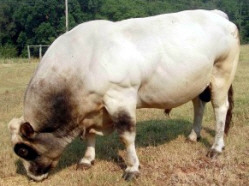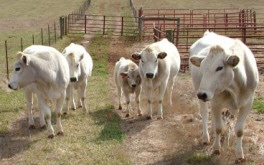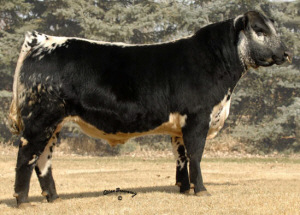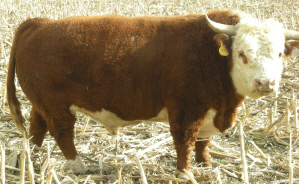



Piemontese
History
Piemontese cattle originate from the region of Piedmont in northwest Italy, a region that is secluded and protected by the Alps mountain range. This area was populated with an ancient European breed of cattle known as Auroch (Bos Primigenius). Descendants of the Aurochs and other domestic European cattle common to the more temperate zones belong to the species of bovine known as Bos Taurus.Approximately 25,000 years ago, Zebu (or Brahman) cattle (Bos Indicus), which were common in tropical areas such as India and Africa, began to migrate from Pakistan, some of which stopped preferring the valleys of the Piedmont region, taking advantage of the natural Alpine barriers.
 Photo courtesy of Beaver Creek Farm, www.beavercreekpiedmontese.com |
There are several breeds from Italy which also show the influence of this Zebu migration – these are the so-called Italian “white breeds" but the similarity to the Piemontese does not go further than the colour.
In 1886, the appearance of double-muscling in Piemontese cattle attracted the attention of breeders, who had the foresight to recognise the enormous potential of this development. The first Italian Herdbook was opened in 1887 and breeding programs designed to improve the herd and eliminate detrimental aspects associated with double-muscling were put in place.
The Myostatin gene was discovered over one hundred years later. It is this gene, that occurs naturally in all mammals, that restricts muscle growth. However, in the case of Piemontese cattle, the gene naturally mutated resulting in the unrestricted muscle development known as double-muscling. Muscle development in Piemontese cattle averages 14 percent higher than in most other breeds, and the Myostatin gene also helps to provide the consistent tenderness of Piemontese beef.
Characteristics
The Piemontese is generally white to light grey in colour with the muzzle (including inside the mouth), around the eyes, ears, tassle of the tail, hooves and horns being black. At birth the coat colour of the calves is of a deep pale fawn.The breed is of medium size with fine bone structure ,confirmation is broad and muscular with a medium sized dewlap. The cows generally weigh around 550-600 kg, at birth the calves weigh on average from 40 to 45 kg.
Piemontese cattle are docile and highly fertile, they exhibit excellent mothering instincts, ample milk yield, and longevity; often producing for greater than nine years. Calving ease is a result of the delay in the manifestation of the double-muscling, usually occurring several weeks after birth. Combined with a light bone structure this results in long slim calves.
 Photo courtesy of Beaver Creek Farm, www.beavercreekpiedmontese.com |
The milk production of the Piemontese is sufficient to suckle the calf; this as a consequence of the double-purpose selection applied on the breed in the past. Some of the Piemontese breeders use the milk for cheese production. The cheeses "Castelmagno", "Bra", "Raschera" and many of the "Tome" coming from the valleys of the region Piemonte are produced with Piemontese milk.
Piemontese are known for their high feed conversion and efficiency, and were ranked first for their feed lot performance ratio by the Great Western Beef Expo in 1991. Higher than average weight gains are common, and in some studies, the Piemontese breed achieved a 4.44 lbs (2 kg) average daily weight gain.
Statistics
Comparative
The Piemontese produces carcasses of considerable value which, thanks to the meat potential and the low fat rates, rank in the highest categories of the EUROP-classification.The mg of cholesterol in a 100g piece of Piemontese beef is just 48.5mg compared with other beef (73mg), pork (79mg), roast chicken (76mg) and sole (52mg).
(www.piemontese.org.uk)
Results from the United States Department of Agriculture's Meat Research Centers Germplasm Evaluation Program, comparing eleven breeds, report that although live weights of Piedmontese were significantly lighter than those of Angus or Herford sires, retail product weight was greater because of the higher dressing and retail product percentage. The unique heritable traits of Piedmontese are passed on in the first cross, meaning that even a 50% Piedmontese will exhibit significantly more red meat with less fat and bone. The report also indicates that Piedmontese are an excellent candidate for use as terminal sire breeds.
Research conducted by the United States Department of Agriculture (USDA) at the MARC Center compared eleven breeds of cattle. The results of these studies confirm that not only is Piemontese beef genetically lower in fat than other breeds, it had the lowest fat thickness, .29-inches, and the greatest tenderness, 11.0 pounds on the Warner Bratzler Shear Force test, of all the breeds in the study. Results also showed that the average Piemontese steak was almost 70 grams heavier than the Hereford-Angus cross steak (357.1 grams compared to 288.3 grams) which is expected due to larger rib-eye areas on Piemontese.
(www.pauscattle.org)
Distribution
Piemontese cattle are Italy's most popular breed and their numbers are growing worldwide. Piemontese can be found in Australia, Brazil, Canada, Denmark, Great Britain, Holland, Mexico, Poland, and New Zealand.References (the above information was cited from the following sites)
www.pauscattle.org
www.piemontese.org.uk
www.piemontais.ca
www.beavercreekpiedmontese.com


